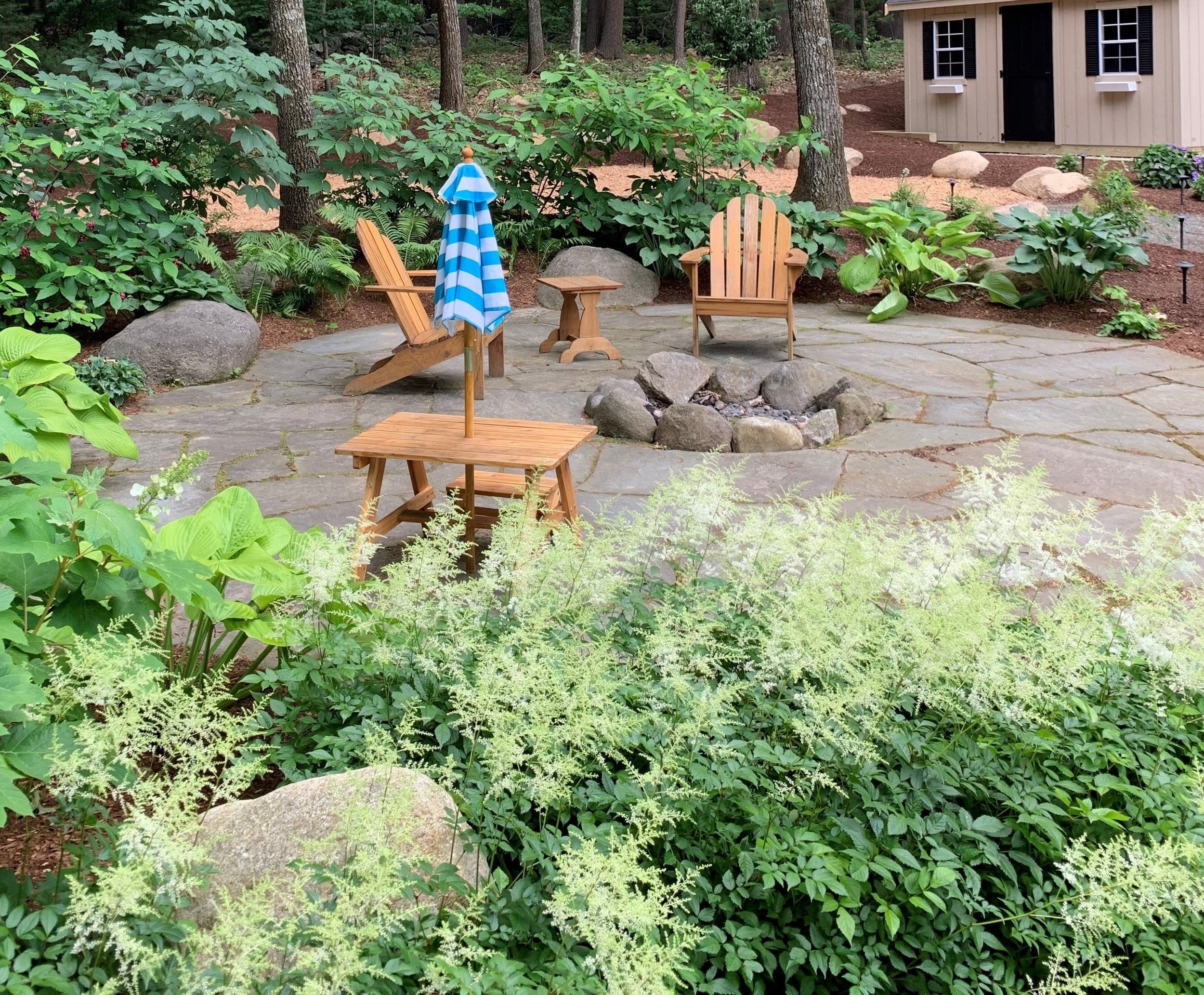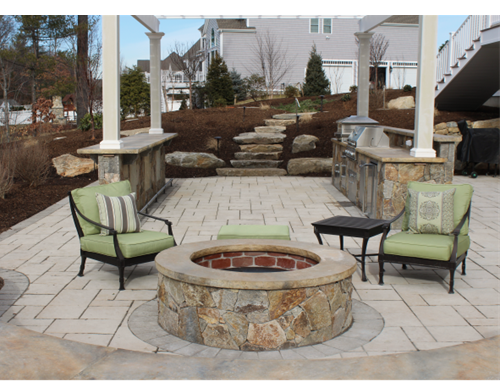Do you deer?
In New England, we know that deer are ever-present, whether we want them to be or not. They are at once our majestic neighbors and lurking garden menaces. So, what do we do? Homeowners and gardeners try all kinds of things – tall fencing, deer netting, granular and liquid repellents, and downright hoping for the best. One effective strategy we recommend is to select deer-resistant plants. These are plants deer avoid due to texture distaste, chemical content, or other natural reasons. These plants come in a variety of colors, forms, and heights and can fulfill your gardening vision. Here are some of our favorites:
Astilbe
Pictured here with white flowers, astilbe is a shade perennial that, unlike the deer-preferred hosta, will steer clear of browsing damage.
Butterfly bush
Shown with purple flowers here, the butterfly bush attracts pollinators rather than deer.
Helleborus
Good in containers and in the ground, the pale flowers of a helleborus plant add a beautiful contrasting element.
Mountain andromeda
The andromeda is a good-sized shrub with red hues that resists deer damage unlike the mountain laurel.
Salvia and Yarrow
Pictured here together, purple salvia and yellow yarrow complement each other along a stone walkway with unique, vibrant flowers.
Stonecrop ‘Autumn Joy’
A sturdy perennial and one of the only varieties of sedum that can turn a deer away, this stonecrop is just starting to turn pink.
Tickseed
These delicate yellow flowers have a cheerful flair and cover a wide area.
Winterberry
Taking it back to the current season, winterberry offers bright, visible red berries in the cold season that bring the birds along.
If you’re looking to start a new planting or hoping to enhance your existing design, give us a call. We’ll give you the tools to take your yard off the menu.
Plan this Winter: Outdoor Living
Outdoor living
What is outdoor living?
Maybe you already know that outdoor living spaces are an extension of the home – an enjoyable way to utilize your outdoor space for entertainment and peacefulness. But did you know that outdoor living spaces are completely customizable? There is no cookie cutter way to organize your yard into a functional and fun space. We start with what matters to you. Do you need a place to sit while you watch your kids on the swing set? Do you want to elevate your gatherings with friends and family? Would you like a quiet place to reflect and regroup? There are an endless number of reasons to want an outdoor living space and just as many ways to make it happen.
Picture yourself having a cup of hot tea some early springtime afternoon in the soft sun on your back patio. Find the comfort of shade under your towering trees as you lounge by the pool on a hot summer day. Feel the warmth coming from your fireplace on a crisp fall evening as you roast marshmallows with your family or friends. We have talented masons and horticulturists who can transform your existing areas into something beautiful that achieves your goals. From natural textured blue mist granite to whimsical purple allium, we have many tools to enhance the beauty and strength of the paths you walk on and the places you rest.
How can you incorporate outdoor living into your lifestyle?
Let’s review some background on the opportunities of outdoor living. If you like to entertain groups, an outdoor living room could be right for you – a patio to congregate on and a fireplace to flock to. A fireside living room with comfortable outdoor seating is relaxing and mesmerizing. It doesn’t hurt to have some barbecue off your sizzling grill either. Top off your experience with an outdoor TV. Watch your current binge show with a pizza just out of your outdoor brick oven or keep it simple with some popcorn and a rom com in your new living space. When the party’s over, collect your thoughts by the bubbling stream and have a peaceful moment to yourself. Contemplation spaces can help you reflect on the beautiful moments you have experienced and imagine those to come.
Why are we talking about this now rather than during grilling season?
The winter is a great time to install an outdoor kitchen so that you are springtime-ready. You can enjoy the entirety of the warmer months your first year having this space. If you are going away on vacation in the summer, that could be a good time for installation as well so that there is no interruption to your day to day. If that’s your preference, maybe consider planning your project this winter to beat the spring rush.
Just because the cold weather is here does not mean that you can’t build on what you have and bring life to your ideas. We are here to help you achieve your vision and excited at the possibility of bringing you more joy in your outdoor life
Winter Interest for a Year-round Yard
Winter Interest
It’s important to love our yards all year round. Winter presents an opportunity to highlight the existing beauty of our landscapes and further beautify them. The types of plants we choose to plant earlier in the year and the steps we take to enhance these features now add up to make an enjoyable and attractive space to experience as we begin to wrap up the year. There is an abundance of winter interest to enjoy and so many ways to get started.
This time of year, you can notice more readily which plants are evergreen. Evergreens keep their foliage throughout the year, whereas deciduous plants lose leaves in the colder months. If evergreens have been designed into your landscape, there may be many shades of green, blue, silver, and yellow apparent right now. In preparation for wintertime, it can be a good idea to plant these evergreens in important “anchor” locations around your house foundation and other beds to make sure there is a sense of fullness when deciduous plants have dropped their leaves.
There may be fewer green leaves right now, but both deciduous and evergreen plants have value – although in different ways – this time of year. There are many features of both deciduous and evergreen plants that capture attention right now. We’ll take a look at a wide range of examples.
Grasses left to height in the cold season can offer, at first, a festive fall look that many of us enjoyed around Thanksgiving time. During the winter, their continued wispiness and height can add structurally interesting elements that offer interest after perennials have been cut back for the end of the year.
If you are interested in pops of color, there is no question about the value of berries – both as an animal food source and a needed splash of brightness in the landscape. Let’s envision a winterberry, a deciduous holly shrub with orangey red berries held starkly against tall, bare stalks. The leaflessness highlights the vibrance of the berry color in a way that is different than, and perhaps equally beautiful to, the fullness of the evergreen blue holly, which has glossy and intricate bluish green leaves and deep red berries.
Berries can attract wildlife that many of us love, and, in general, evergreens provide habitat for small wildlife in the winter by sheltering them from the cold and wind. Think of cardinals, the beautiful birds that don’t migrate from our area and instead feed on available berries, nuts, and seeds, while finding a home in evergreen trees and shrubs. Many find visits from cardinals outside their windows to be a welcome and magical encounter this time of year, and we have evergreens to thank in this case.
On the other side of things, deciduous plants can provide interest through their showy twig color. How can we overstate the beauty of a red twig dogwood in the winter, especially against a snowy white backdrop? These burgundy stems, made visible by leaf drop, add structure and color this time of year. This unique feature, similarly enviable in the yellow twig dogwood, can highlight certain areas of your yard by drawing in a lot of attention.
Leaf drop also allows attention to fall onto the trunks of trees, like Satomi Kousa dogwoods, that have amazing bark that peels or “exfoliates,” forming a complex textural image of varying shades from cream to gray. Elements of deciduous trees like exfoliating bark are special to this time of year because they are much more visible without the cover of leaves.
Another element made visible during the winter is the interesting formation of trunks of plants like the weeping Japanese maple or cherry trees. Some of these plants have contorted stems that are uncommon and highly prized. The weeping cherry may lose its green leaves for the winter, but its interesting structure becomes apparent both because of the weeping branches and the windows between them that give way to the stem.
Now that we’ve discussed the wonderful natural elements of plants in the winter, what can we do to enhance this scene? Uplighting a tree, especially large ones with interesting structures, is extra effective this time of year and makes for a spectacular show during the more numerous dark hours of a winter day. Quite literally a spotlight on your most magnificent landscape features, landscape lighting enhances the value of your trees, especially during the winter months, when the structure is more noticeable.
If an additional pop of color is what you’re looking for at night, we also set up holiday lights, shining a cheerful light on the formation of trees and shrubs in time for the holiday season. This is a homerun way to add interest to your landscape, cashing in on the features of your plants that are already present and waiting to be accentuated.
If you are looking for something more, consider container gardens. We design and create winter container gardens – small to large – using the greenery of evergreens to add festive and creative interest in planters at high-visibility areas. We use boughs and tips from firs, pines, cedars, spruces, and other colorful plants that are vibrant in the winter. We accent the greenery arrangements with decorative elements, including berries, birch logs, and pinecones, to bring the foliage to life.
We can focus on the natural beauty of the winter landscape and even add to it to better enjoy our surroundings this year and for many to come. Winter can inspire creativity as the warm feeling of a yard you love can motivate us to find solutions that bring you joy even in the cold. Give us a call to get started on any project that is of interest to you this time of year, and we are happy to help.




























